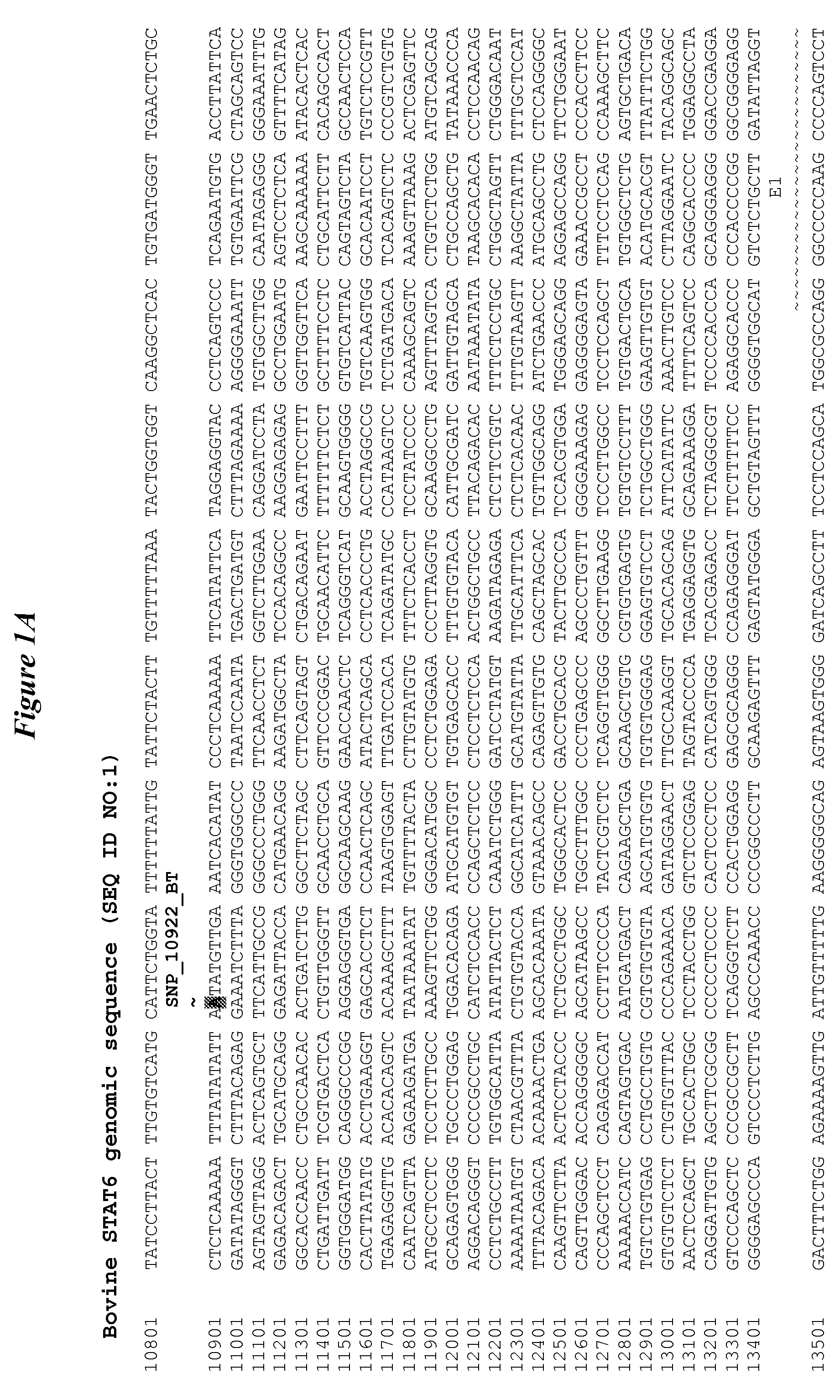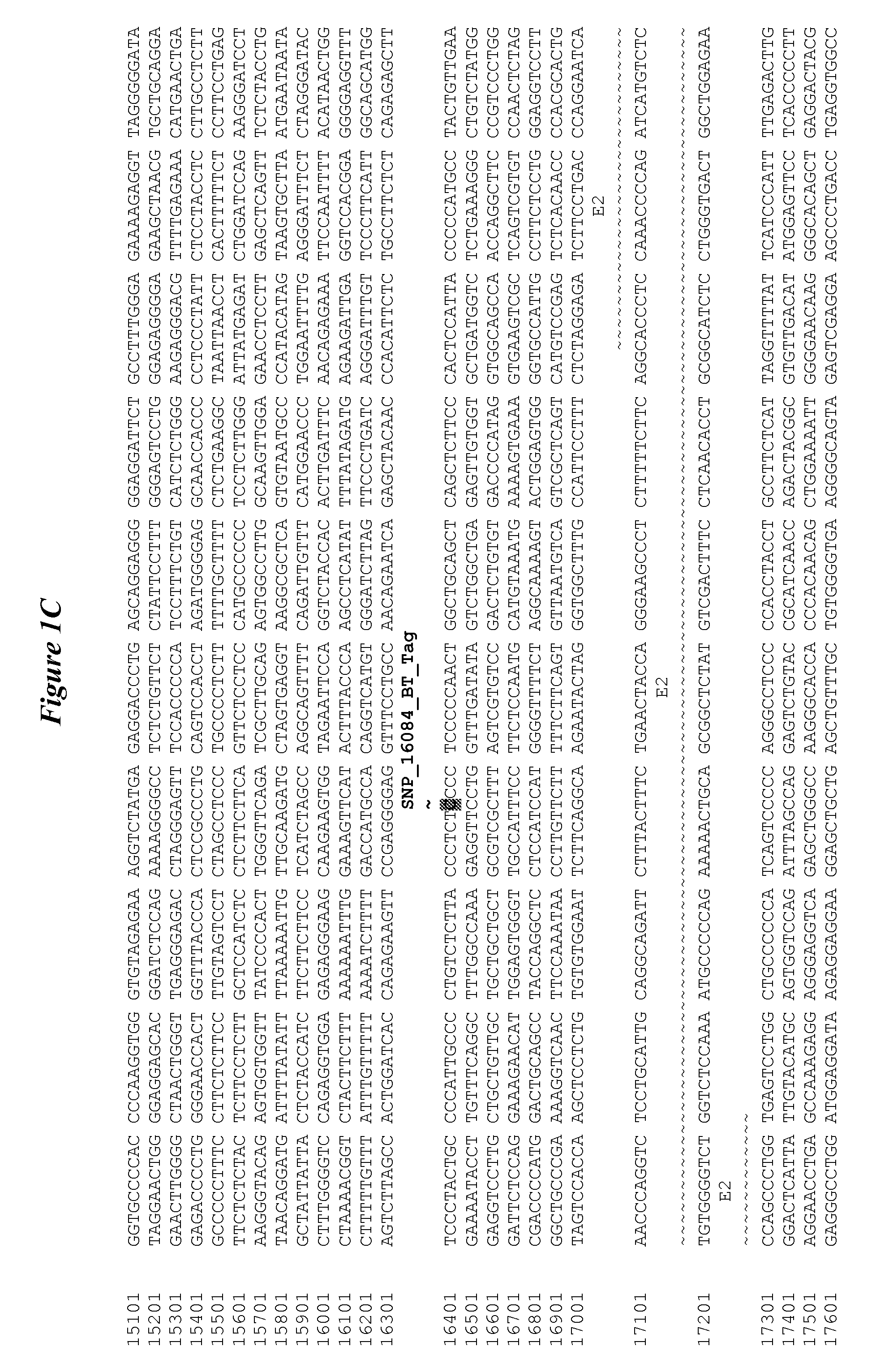Stat6 effects on livestock animal growth
a technology of stat6 and livestock, applied in the field of stat6 effects on livestock animal growth, can solve the problems of lower overall production system efficiency, lower profits, and higher beef production costs, and achieve the effects of improving profitability, improving quality, and palatable meat production
- Summary
- Abstract
- Description
- Claims
- Application Information
AI Technical Summary
Benefits of technology
Problems solved by technology
Method used
Image
Examples
example 1
Cattle Breed DNA Resource for SNP Discovery
[0172]The cattle breed DNA resource consists of approximately 6 animals of each of 12 cattle breeds (5 Black Angus, 6 Red Angus, 3 Horned Hereford, 3 Polled Hereford, 4 Charolais, 5 Simmental, 4 Limousine, Chianina, 6 Brahman, Santa Gertrudis, 3 Wagyu). The animals of each breed were selected to be unrelated at least 3 generations back. An effort was made to have the presence of diverse lines or types within each breed. At least 5 straws of semen were obtained from each animal. The semen came from 3 sources: purchased by Merial from semen Al companies, from Charles Farber (University of California at Davis) and from Milton Thomas (New Mexico State). Tables 1 and 2 show the details of the individual samples, source and number of semen straws. High quality DNA was extracted from one semen straw from each animal and four straws kept frozen for future use. DNA was extracted using PureGene DNA extraction kit, quantified on a UV spectrophotometer...
example 2
SNP Discovery Platform Using Resequencing Strategy
[0173]A strategy for SNP discovery was developed for this project. SNPs were identified by resequencing candidate genes in panels of 48 animals (9 breeds) from the discovery panel. See, Table 2. A genomic reference sequence was assembled from GenBank sequences (genomic, mRNA and ESTs) and from Ensembl bovine genome sequences. The sequence was annotated to identify exons, introns, 2000 bp of the promoter and 1000 bp of the 3′ untranslated region. Repetitive and low-complexity sequences were masked with RepeatMasker to prevent sequencing repetitive regions of the genes.
[0174]The sequencing project was outsourced to SeqWright (Houston, Tex.). SeqWright provided a full service of automated sequencing with a brief annotation and SNP discovery. Sequence traces were downloaded from SeqWright and resembled at UCDavis using software CodonCode Aligner to notate and discover SNPs.
[0175]The genotype of the sequenced animals for each gene were an...
example 3
Identify SNPs in STAT6
[0176]Using a bioinformatics-based method to identify sequence homologies between bovine microsatellites (Farber and Medrano 2003, Animal Genetics 34, 11-18), and gene sequencing it was demonstrated that microsatellite ETH10 is located within the first exon of the bovine STAT6 gene. ETH10 has been strongly associated in earlier work with marbling in Wagyu cattle (Barendse, Australia), with a suggestion of RDH5 as being the causative gene.
[0177]It was proposed that the association between ETH10 and marbling is either due to the repeat itself or polymorphisms with the STAT6 gene, which alter its function. Earlier, 3 SNPs between different breeds of dairy cattle were identified. 39 SNPs across the complete gene have been identified overall, in the 48 animals breed panel. FIG. 1 shows an annotated sequence of the bovine STAT6 gene and the position of Tag SNPs statistically correlated with economically important traits in beef cattle. Table 3 shows flanking sequenc...
PUM
| Property | Measurement | Unit |
|---|---|---|
| Fraction | aaaaa | aaaaa |
| Length | aaaaa | aaaaa |
| Weight | aaaaa | aaaaa |
Abstract
Description
Claims
Application Information
 Login to View More
Login to View More - R&D
- Intellectual Property
- Life Sciences
- Materials
- Tech Scout
- Unparalleled Data Quality
- Higher Quality Content
- 60% Fewer Hallucinations
Browse by: Latest US Patents, China's latest patents, Technical Efficacy Thesaurus, Application Domain, Technology Topic, Popular Technical Reports.
© 2025 PatSnap. All rights reserved.Legal|Privacy policy|Modern Slavery Act Transparency Statement|Sitemap|About US| Contact US: help@patsnap.com



